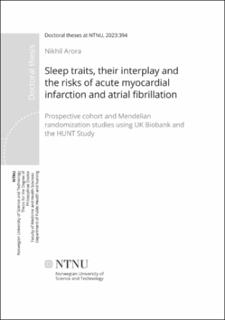| dc.contributor.advisor | Strand, Linn Beate | |
| dc.contributor.advisor | Richmond, Rebecca | |
| dc.contributor.advisor | Åsvold, Bjørn Olav | |
| dc.contributor.advisor | Skarpsno, Eivind Schjelderup | |
| dc.contributor.advisor | Bhatta, Laxmi | |
| dc.contributor.author | Arora, Nikhil | |
| dc.date.accessioned | 2024-01-31T08:22:36Z | |
| dc.date.available | 2024-01-31T08:22:36Z | |
| dc.date.issued | 2023 | |
| dc.identifier.isbn | 978-82-326-7487-9 | |
| dc.identifier.issn | 2703-8084 | |
| dc.identifier.uri | https://hdl.handle.net/11250/3114740 | |
| dc.description.abstract | Poor sleep is a major public health concern, with an estimated 30% of the general population reportedly experiencing one or more insomnia symptoms at any given point in time. Good sleep entails more than the mere absence of sleep disorders, and sleep health can be assessed through measurable constructs of sleep, including sleep duration, sleep efficiency, sleep timing (e.g., chronotype), alertness/sleepiness, and sleep satisfaction/quality. In recent years, there has been a growing emphasis on the significance of sleep health in relation to critical bodily functions such as autonomic dysregulation and hormonal disturbances, which are potentially linked to cardiometabolic risk factors and cardiovascular diseases (CVDs).
CVDs, including acute myocardial infarction (AMI), represent a significant contribution to the burden of disability-adjusted life years and premature mortality on a global scale. Atrial fibrillation (AF) — being the most common arrhythmia — exerts a substantial impact on morbidity and mortality, and its prevalence is projected to double by the year 2050. Notably, a considerable proportion of CVDs cannot be explained by established risk factors, such as unfavorable lipid profiles, high blood pressure, diabetes, and cigarette smoking. Numerous studies have established links between various individual sleep traits (i.e., insomnia symptoms, sleep duration, and chronotype) and an elevated risk of CVD development. However, sleep traits are often interconnected, and only a limited number of studies have assessed their joint effects on AMI/AF risk.
We have leveraged data obtained from UK Biobank and the second survey of the Trøndelag Health Study (HUNT2) to investigate the joint influence of sleep traits on the risks of incident AMI and AF using prospective observational and Mendelian randomization (MR) study designs. Furthermore, we assessed relative excess risk due to interaction (RERI) for the joint association of sleep traits on an additive scale.
Through our observational analyses, we detected the joint associations of certain sleep traits on the risks of AMI and AF. Specifically, individuals who exhibited combinations of certain sleep traits (i.e., insomnia symptoms with short sleep duration, insomnia symptoms with long sleep duration, insomnia symptoms with evening chronotype, short sleep duration with evening chronotype, and long sleep duration with evening chronotype) had higher risk of incident AMI than those who exhibited only one sleep trait. Notably, interaction was observed for insomnia symptoms with long sleep duration. In the context of AF, we observed that individuals with the combinations of insomnia symptoms with long sleep duration, as well as insomnia symptoms with evening chronotype had higher risk than those who exhibited only one sleep trait; however, no substantial interaction was found.
In our factorial MR analyses, we detected the impacts of genetic predisposition to two sleep traits together on the risks of both AMI and AF. Although individuals with genetic predisposition to insomnia symptoms with short sleep duration, insomnia symptoms with morning chronotype, and short sleep duration with morning chronotype had higher risks of incident AMI and AF than those genetically predisposed to only one sleep trait, no interaction was found.
Since we could not triangulate the findings across the observational and MR study designs in this thesis, it is difficult to synthesize overall conclusions. Despite this, our results add to the body of evidence regarding the adverse health effects of certain sleep traits and their combinations. For instance, healthy sleep of adequate duration (7–8 h) that is free from insomnia symptoms can reduce the risks of incident AMI and AF, which could be relevant for preventive initiatives. Further research on this topic is warranted, particularly to address the underlying mechanisms of these observed associations. | en_US |
| dc.language.iso | eng | en_US |
| dc.publisher | NTNU | en_US |
| dc.relation.ispartofseries | Doctoral theses at NTNU;2023:394 | |
| dc.relation.haspart | Paper 1: Arora, Nikhil; Richmond, Rebecca C.; Brumpton, Ben Michael; Åsvold, Bjørn Olav; Dalen, Håvard; Skarpsno, Eivind Schjelderup; Strand, Linn B. Self-reported insomnia symptoms, sleep duration, chronotype and the risk of acute myocardial infarction (AMI): a prospective study in the UK Biobank and the HUNT Study. European Journal of Epidemiology (EJE) 2023 ;Volum 38. s. 643-656 - This article is licensed under a Creative Commons Attribution 4.0 International License CC BY | en_US |
| dc.relation.haspart | Paper 2: Arora, Nikhil; Bhatta, Laxmi; Skarpsno, Eivind Schjelderup; Dalen, Håvard; Åsvold, Bjørn Olav; Brumpton, Ben Michael; Richmond, Rebecca C.; Strand, Linn Beate. Investigating the causal interplay between sleep traits and risk of acute myocardial infarction: a Mendelian randomization study. BMC Medicine 2023 ;Volum 21.(1) https://doi.org/10.1186/s12916-023-03078-0 - This article is licensed under a Creative Commons Attribution 4.0 International License CC BY | en_US |
| dc.relation.haspart | Paper 3:
Arora, Nikhil; Brumpton, Ben Michael; Åsvold, Bjørn Olav; Loennechen, Jan Pål; Malmø, Vegard; Bhatta, Laxmi; Skarpsno, Eivind Schjelderup; Richmond, Rebecca C.; Strand, Linn Beate.
A Mendelian randomization study investigating the role of sleep traits and their joint effects on the incidence of atrial fibrillation. | en_US |
| dc.title | Sleep traits, their interplay and the risks of acute myocardial infarction and atrial fibrillation: Prospective cohort and Mendelian randomization studies using UK Biobank and the HUNT Study | en_US |
| dc.type | Doctoral thesis | en_US |
| dc.subject.nsi | VDP::Medical disciplines: 700::Health sciences: 800::Community medicine, Social medicine: 801 | en_US |

